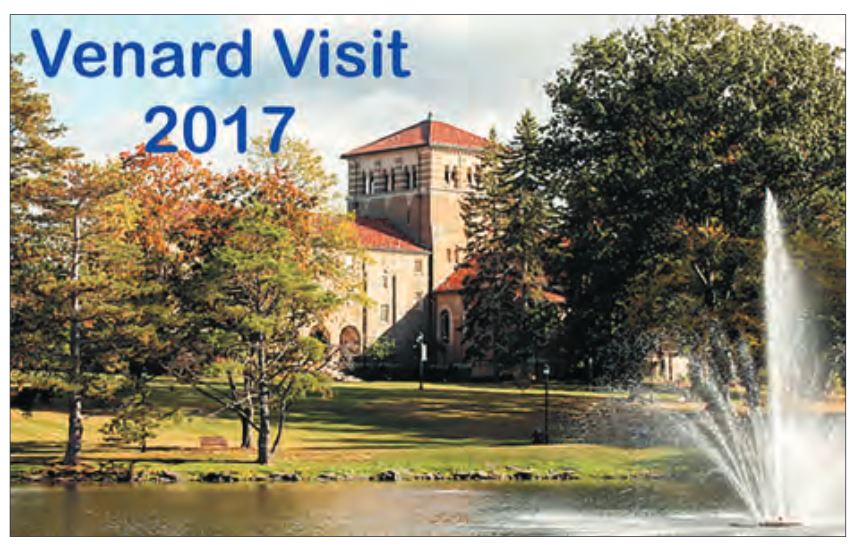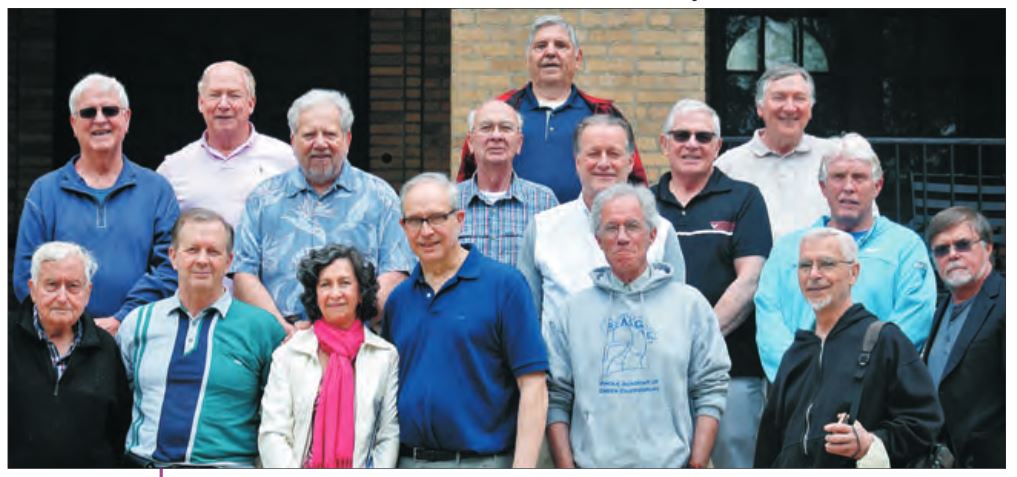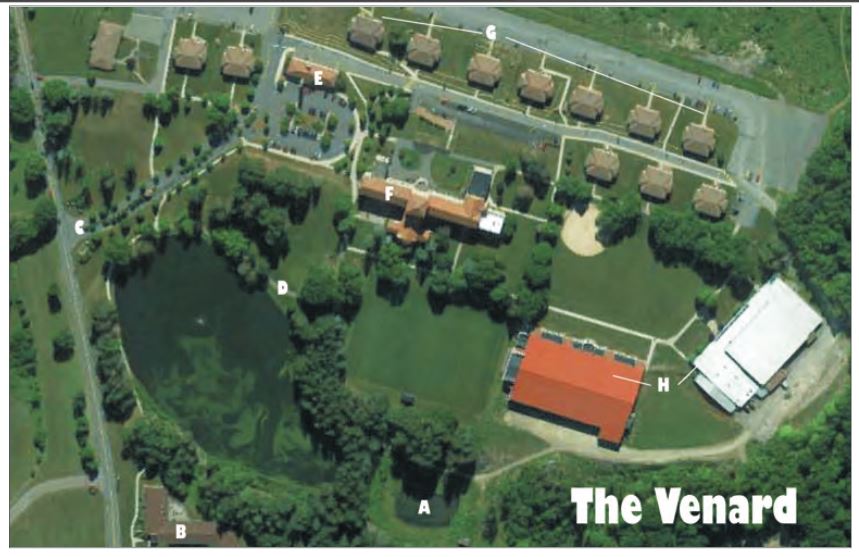
Venard Visit - Fiftieth Anniversary of closing
To mark the fiftieth anniversary of the closing of the
Venard (minor seminary) in Clarks Summit, Penn., fifteen members
from several graduating classes visited what is now Clarks Summit
University on the weekend of May 19–21, 2017. The group's
reflections are published here.

(Back row, l-r): Bill Dillon, Jim McCormick, Chuck Morel, Gerry
Will, John Zammit, Adam Kretowicz, Pete Berner, Jim Paradis,
Marty McDonough
(Front row, l-r): Carmelo Mallia, Jim Borer, Amilbia Mundy, Bob Mundy,
Michael Canavan, Norm Gauthier, Larry Blob
We sat around a large round metal table in a shaded rock-walled
enclosure where Brother Fred's apple orchard once flourished. Just six
of us for that Friday afternoon moment, though nearly another dozen
would join us that evening or on Saturday. Laughing at the memories,
inwardly alone with private thoughts.
Not unlike visiting the hallowed ground of a memorialized
battlefield, mindful of where you walked and what you disturbed, we
each knew that something special happened here. That something special
was us. Call it "contact magic." Touch a wall, walk a path, re-visit
the view from a window, and the past welcomes you back, in a rush, and
not absent emotion. Time is irrelevant and you don't accept it's been
fifty years since that last touch, walk, or window.
And so it was during a weekend in May fifteen former
seminarians and several wives representing a range of high school
Venard graduations came "home" to Clarks Summit, Penn., to commemorate
fifty years since Maryknoll Junior Seminary closed its massive oak
doors, the property soon sold. Remaining classes were moved elsewhere
and new residents shortly arrived.
Today the grounds house the faculty and students of the
Baptist-operated Summit University. We were giddy kids that warm
Friday afternoon, in from Washington, California, Florida, Michigan,
and points in-between. It took more than a few wrong turns through new
neighborhoods before finding Abington Road, then the old stone church
and the once familiar turn east over a pair of rolling hills bisecting
former pastures once populated by Brother John's cows.
The "T" intersection and the small grocery that was once the
epicenter of Clarks Green just a block or two north gone, new
construction having erased any evidence of the movie that played in
our heads. Moments later, as though awakened from a long dormant
dream, aptly named Bell Mountain in the distance, the iconic bell
tower rose above the distant trees. A half century had passed since
most last saw this picture.
Whatever the decision to choose Maryknoll, Clarks Summit, and
a suitcase stuffed with dark suits over one's hometown high school,
this is where it began – for most, our first time away from the only
home we knew, the unknown, unfamiliar, and a million questions just
beyond the rise. In May 2017, the memory again had a face. We met in
the Jackson Hall rotunda outside the former chapel on Saturday
morning, no longer racing to beat the door closing (latecomers were in
for quality time with the dean of discipline). The tower bells still
ring, though automation has replaced the long white cords that once
dangled near the chapel entrance.
To look back down the one long hall, little had changed.
Summoned by the rector, en route to a Saturday evening reel-to-reel
viewing of The Magnificent Seven , or waiting in line for your turn to
call home, light bounces off the marble floors and stone walls as it
has for the past ninety-eight years. A few short steps the other way
and the academic wing, the "Dew Lab" still anchoring the far end, has
changed not at all. A floor below, the gym is now one large open
classroom, though frayed black wire mesh still covers the upper
windows.
If you can accept the absence of the altar, pews, and other
remnants of what had been the chapel, little has changed within as
well. The large, well-lit space is now a peaceful lounge, ideal for
quiet reflection. The pillars, high chiseled inscriptions, floors,
walls, windows – they still speak. The not-so-well-known back stairway
from the sanctuary through the former TV room brought us into the old
refectory, now a library, as are the rec room and music room, where
fifty years earlier we mellowed to Maryanne Faithful, the Beatles, the
Stones, while debating the Vietnam War, the curriculum, the noon meal,
maybe even Oliver Twist.
We remembered hot dogs and beans on Saturdays, having to sport
the white apron to leave the table, "Fruit Loops," silence until the
hand-bell rang and the podium reader was dismissed, Visiting Sunday
treats, sounds and steam spewing from the dishwashing monster and –
truth be told – those late-night refectory raids. The ledged,
wooden-windowed door to the small condiments "store" remains.
Where we once sorted "Mother's Laundry" into personal cubicles
is now office, as are much of the dormitories, though those tall
mahogany lockers remain in many quarters. All our worldly possessions
were kept either there, in the locker room, or inside a study hall
desk. What else could we possibly need those nine months.
We visited the former infirmary, where carefully dipping one's
thermometer in the hot tea might earn you another day's rest, further
delaying some dreaded exam. A visit to the bell tower itself was off
limits, but that had always been the case.
Still...we recalled the late-night smoking session when one of
the gathered group tripped over a darkened wire, setting the chimes to
sing well af- ter lights out. Brother Fred's Apple Cellar is now a
well-appor- tioned student coffee shop, but the rest of that fabulous
orchard has been replaced with faculty and student living quarters.
The Sister's residence was torn down fifteen years ago, the
red barn gone since the 1970s. The Brother's residence is now a music
building – the memory of "penal squad" and sorting screws under the
watchful eyes of Brother Paul haunts us still.
We walked the "Rosary path" that still encloses the baseball
field, some of us remembering the interrupted soccer game when we
heard JFK had been shot. The pitcher's rubber and home plate remain
just as we last walked off the field against, perhaps, Mt. Holyoke,
though deep left and right fields now include impressive sporting,
dining, recreational, and other student life structures. Still, one
can't help but notice that within the confines of that black-tarred
path, so little has changed. Mindful of where we walked and what we
disturbed, still laughing but as deep in thought, we remembered why
this place was special, why we returned each September then, as we did
now.
Further afield, the pool is gone, now just a wetland. The
Lake – that will never change. We spoke of pulling Brother John's
tractor out of the ice, hockey games, "Capture the Flag" in the hill
beyond, feeding the ducks, the path through the pasture for an
afternoon walk to Clarks Green for a "Yoo-hoo" or on to town for the
latest 45-rpm by the Searchers or Four Seasons.
The two-lane road that passes the Lake is still referred to as
"Venard Road," the toboggan hill now the home of a Baptist Church and
a Jewish retirement home. We laughed some more and swapped fresh
stories, many closely held in secrecy until that weekend, over a
handful of meals and just maybe a few drinks.
Clarks Summit is no longer the sleepy little pit stop it was
back then, but once outside its confines, those small quintessentially
American towns on the way to the Nicolson Bridge remain frozen in
time. And to think we once hiked those hills, sack lunch in hand,
mischief somewhere on the agenda. After all, we were young kids:
immortal, bulletproof, forever pushing the envelope to its limit, our
whole lives ahead of us. It's been seventy-seven years since Thomas
Wolfe published "You Can't Go Home Again",. Wolfe never met us.
The current property layout of the former Venard – now Clarks
Summit University – is shown in this Google image

A the old pool and shed
B
the original (then-named) Summit
University seminary building, now (since
2016) owned by the Roman Catholic
Priestly Fraternity of St. Peter
C
main entrance (no longer on the "S"
Road)
D
pond
E
former Brothers' House
F
main building (now Jackson Hall)
G
housing for faculty and students
H
buildings constructed by Baptist
College (now Clarks Summit University)